Investigation of the Effect of Hybrid Nanofiller on the Mechanical Performance and Surface Properties of Bio-Based Polylactic Acid/Polyolefin Elastomer (PLA/POE) Blend
Abstract
1. Introduction
2. Experimental
2.1. Materials
2.2. Sample Preparation and Coding
2.3. Morphology Characterization
2.4. Rheological Characterization
2.5. Mechanical Properties Measurement
3. Results and Discussion
3.1. Morphology Development in PLA/POE Blends Containing Nanoclay
3.2. Surface Analysis of PLA/POE Blend and PLA/POE Nanocomposite Samples
3.3. Rheological Properties of PLA/POE Nanocomposites
3.4. Mechanical Performance of the Prepared PLA/POE Nanocomposites
4. Conclusions
Author Contributions
Funding
Institutional Review Board Statement
Data Availability Statement
Acknowledgments
Conflicts of Interest
References
- Reddy, M.M.; Vivekanandhan, S.; Misra, M.; Bhatia, S.K.; Mohanty, A.K. Biobased plastics and bionanocomposites: Current status and future opportunities. Prog. Polym. Sci. 2013, 38, 1653–1689. [Google Scholar] [CrossRef]
- Babu, R.P.; O’connor, K.; Seeram, R. Current progress on bio-based polymers and their future trends. Prog. Biomater. 2013, 2, 8. [Google Scholar] [CrossRef] [PubMed]
- Rosenboom, J.-G.; Langer, R.; Traverso, G. Bioplastics for a circular economy. Nat. Rev. Mater. 2022, 7, 117–137. [Google Scholar] [CrossRef]
- Narancic, T.; Cerrone, F.; Beagan, N. Recent Advances in Bioplastics: Application and Biodegradation. Polymers 2020, 12, 920. [Google Scholar] [CrossRef]
- Millican, J.M.; Agarwal, S. Plastic Pollution: A Material Problem? Macromolecules 2021, 54, 4455–4469. [Google Scholar] [CrossRef]
- Babaei, A.; Haji Abdolrasouli, M.; Rostami, A. Polylactic acid/polycaprolactone bionanocomposites containing zinc oxide nanoparticles: Structure, characterization and cytotoxicity assay. J. Thermoplast. Compos. Mater. 2022, 08927057221118823. [Google Scholar] [CrossRef]
- Jem, K.J.; Tan, B. The development and challenges of poly (lactic acid) and poly (glycolic acid). Adv. Ind. Eng. Polym. Res. 2020, 3, 60–70. [Google Scholar] [CrossRef]
- Ilyas, R.A.; Sapuan, S.M.; Harussani, M.M.; Hakimi, M.; Haziq, M.Z.M.; Atikah, M.S.N.; Asyraf, M.R.M.; Ishak, M.R.; Razman, M.R.; Nurazzi, N.M. Polylactic acid (PLA) biocomposite: Processing, additive manufacturing and advanced applications. Polymers 2021, 13, 1326. [Google Scholar] [CrossRef]
- Nagarajan, V.; Mohanty, A.K.; Misra, M. Perspective on polylactic acid (PLA) based sustainable materials for durable applications: Focus on toughness and heat resistance. ACS Sustain. Chem. Eng. 2016, 4, 2899–2916. [Google Scholar] [CrossRef]
- Deeraj, B.D.S.; Jayan, J.S.; Saritha, A.; Joseph, K. 8—PLA-based blends and composites. In Biodegradable Polymers, Blends and Composites; Elsevier: Amsterdam, The Netherlands, 2022; ISBN 9780128237915. [Google Scholar] [CrossRef]
- Jiménez, L.; Mena, M.; Prendiz, J.; Salas, L.; Vega-Baudrit, J. Polylactic acid (PLA) as a bioplastic and its possible applications in the food industry. J. Food Sci. Nutr. 2019, 5, 2–6. [Google Scholar]
- Liu, S.; Qin, S.; He, M.; Zhou, D.; Qin, Q.; Wang, H. Current applications of poly (lactic acid) composites in tissue engineering and drug delivery. Compos. Part B Eng. 2020, 199, 108238. [Google Scholar] [CrossRef]
- Ncube, L.K.; Ude, A.U.; Ogunmuyiwa, E.N.; Zulkifli, R.; Beas, I.N. Environmental impact of food packaging materials: A review of contemporary development from conventional plastics to polylactic acid based materials. Materials 2020, 13, 4994. [Google Scholar] [CrossRef]
- Lopes Alves, J.; de Tarso Vieira e Rosa, P.; de Redondo Realinho, V.C.; de Sousa Pais Antunes, M.; Ignacio Velasco, J.; Morales, A.R. Single and hybrid organoclay-filled PLA nanocomposites: Mechanical properties, viscoelastic behavior and fracture toughening mechanism. J. Appl. Polym. Sci. 2021, 138, 50784. [Google Scholar] [CrossRef]
- Bai, T.; Zhu, B.; Liu, H.; Wang, Y.; Song, G.; Liu, C.; Shen, C. Biodegradable poly (lactic acid) nanocomposites reinforced and toughened by carbon nanotubes/clay hybrids. Int. J. Biol. Macromol. 2020, 151, 628–634. [Google Scholar] [CrossRef]
- Nematollahi, M.; Jalali-Arani, A.; Modarress, H. Effect of nanoparticle localization on the rheology, morphology and toughness of nanocomposites based on poly(lactic acid)/natural rubber/nanosilica. Polym. Int. 2019, 68, 779–787. [Google Scholar] [CrossRef]
- Tajdari, A.; Babaei, A.; Goudarzi, A.; Partovi, R.; Rostami, A. Hybridization as an efficient strategy for enhancing the performance of polymer nanocomposites. Polym. Compos. 2021, 42, 6801–6815. [Google Scholar] [CrossRef]
- Tian, J.; Cao, Z.; Qian, S.; Xia, Y.; Zhang, J.; Kong, Y.; Sheng, K.; Zhang, Y.; Wan, Y.; Takahashi, J. Improving tensile strength and impact toughness of plasticized poly (lactic acid) biocomposites by incorporating nanofibrillated cellulose. Nanotechnol. Rev. 2022, 11, 2469–2482. [Google Scholar] [CrossRef]
- Phetwarotai, W.; Zawong, M.; Phusunti, N.; Aht-Ong, D. Toughening and thermal characteristics of plasticized polylactide and poly (butylene adipate-co-terephthalate) blend films: Influence of compatibilization. Int. J. Biol. Macromol. 2021, 183, 346–357. [Google Scholar] [CrossRef]
- Mulchandani, N.; Masutani, K.; Kumar, S.; Yamane, H.; Sakurai, S.; Kimura, Y.; Katiyar, V. Toughened PLA-b-PCL-b-PLA triblock copolymer based biomaterials: Effect of self-assembled nanostructure and stereocomplexation on the mechanical properties. Polym. Chem. 2021, 12, 3806–3824. [Google Scholar] [CrossRef]
- McCutcheon, C.J.; Zhao, B.; Jin, K.; Bates, F.S.; Ellison, C.J. Crazing Mechanism and Physical Aging of Poly (lactide) Toughened with Poly (ethylene oxide)-block-poly (butylene oxide) Diblock Copolymers. Macromolecules 2020, 53, 10163–10178. [Google Scholar] [CrossRef]
- Hamad, K.; Kaseem, M.; Ayyoob, M.; Joo, J.; Deri, F. Polylactic acid blends: The future of green, light and tough. Prog. Polym. Sci. 2018, 85, 83–127. [Google Scholar] [CrossRef]
- Alias, N.F.; Ismail, H. An overview of toughening polylactic acid by an elastomer. Polym.-Plast. Technol. Mater. 2019, 58, 1399–1422. [Google Scholar] [CrossRef]
- Maroufkhani, M.; Katbab, A.; Liu, W.; Zhang, J. Polylactide (PLA) and acrylonitrile butadiene rubber (NBR) blends: The effect of ACN content on morphology, compatibility and mechanical properties. Polymer 2017, 115, 37–44. [Google Scholar] [CrossRef]
- Tessanan, W.; Chanthateyanonth, R.; Yamaguchi, M.; Phinyocheep, P. Improvement of mechanical and impact performance of poly (lactic acid) by renewable modified natural rubber. J. Clean. Prod. 2020, 276, 123800. [Google Scholar] [CrossRef]
- Gigante, V.; Canesi, I.; Cinelli, P.; Coltelli, M.B.; Lazzeri, A. Rubber toughening of polylactic acid (PLA) with poly (butylene adipate-co-terephthalate)(PBAT): Mechanical properties, fracture mechanics and analysis of ductile-to-brittle behavior while varying temperature and test speed. Eur. Polym. J. 2019, 115, 125–137. [Google Scholar] [CrossRef]
- Zhao, X.; Liu, J.; Li, J.; Liang, X.; Zhou, W.; Peng, S. Strategies and techniques for improving heat resistance and mechanical performances of poly (lactic acid)(PLA) biodegradable materials. Int. J. Biol. Macromol. 2022, 218, 115–134. [Google Scholar] [CrossRef]
- Long, R.; Long, S.; Zou, L.; Huang, Z.; Huang, Y.; Hu, C.; Li, D.; Li, X. Rheology, crystallization, and enhanced mechanical properties of uniaxially oriented ethylene–octene copolymer/polyolefin elastomer blends. Polymer 2022, 243, 124655. [Google Scholar] [CrossRef]
- Zanchin, G.; Leone, G. Polyolefin thermoplastic elastomers from polymerization catalysis: Advantages, pitfalls and future challenges. Prog. Polym. Sci. 2021, 113, 101342. [Google Scholar] [CrossRef]
- Mohite, A.S.; Rajpurkar, Y.D.; More, A.P. Bridging the gap between rubbers and plastics: A review on thermoplastic polyolefin elastomers. Polym. Bull. 2021, 79, 1309–1343. [Google Scholar] [CrossRef]
- Song, X.; Cao, L.; Tanaka, R.; Shiono, T.; Cai, Z. Optically transparent functional polyolefin elastomer with excellent mechanical and thermal properties. ACS Macro Lett. 2019, 8, 299–303. [Google Scholar] [CrossRef]
- Zhou, J.; Yao, Z.; Zhou, J. Crystallinity and mechanical properties of PLA/POE blends. Adv. Mater. Res. 2011, 336, 886–890. [Google Scholar] [CrossRef]
- Daneshpayeh, S.; Ghasemi, F.A.; Ghasemi, I. Experimental investigation on mechanical properties of nanocomposites based on poly lactic acid/polyole fi n elastomer reinforced with multi-walled carbon nanotubes, and graphene nanoplatelets. Polym. Polym. Compos. 2022, 30, 1–13. [Google Scholar] [CrossRef]
- Jalalifar, N.; Kaffashi, B.; Ahmadi, S. The synergistic reinforcing effects of halloysite nanotube particles and polyolefin elastomer-grafted-maleic anhydride compatibilizer on melt and solid viscoelastic properties of polylactic acid/polyolefin elastomer blends. Polym. Test. 2020, 91, 106757. [Google Scholar] [CrossRef]
- Rafiee, R.; Shahzadi, R. Mechanical properties of nanoclay and nanoclay reinforced polymers: A review. Polym. Compos. 2019, 40, 431–445. [Google Scholar] [CrossRef]
- Guo, F.; Aryana, S.; Han, Y.; Jiao, Y. A review of the synthesis and applications of polymer–nanoclay composites. Appl. Sci. 2018, 8, 1696. [Google Scholar] [CrossRef]
- Jawaid, M.; Qaiss, A.; Bouhfid, R. Nanoclay Reinforced Polymer Composites; Springer: Berlin/Heidelberg, Germany, 2016. [Google Scholar]
- Shettar, M.; Kini, U.A.; Sharma, S.; Hiremath, P. Study on mechanical characteristics of nanoclay reinforced polymer composites. Mater. Today Proc. 2017, 4, 11158–11162. [Google Scholar] [CrossRef]
- Asadi, Z.; Javadi, A.; Mohammadzadeh, F.; Alavi, K. Investigation on the role of nanoclay and nano calcium carbonate on morphology, rheology, crystallinity and mechanical properties of binary and ternary nanocomposites based on PLA. Int. J. Polym. Anal. Charact. 2021, 26, 1–16. [Google Scholar] [CrossRef]
- Zhu, B.; Li, W.; Song, J.; Wang, J. Structure and properties of polypropylene/polyolefin elastomer/organic montmorillonite nanocomposites. J. Macromol. Sci. Part B 2019, 58, 73–87. [Google Scholar] [CrossRef]
- Miles, I.S.; Zurek, A. Preparation, structure, and properties of two-phase co-continuous polymer blends. Polym. Eng. Sci. 1988, 28, 796–805. [Google Scholar] [CrossRef]
- Oliaei, E.; Kaffashi, B. Investigation on the properties of poly(l-lactide)/thermoplastic poly(ester urethane)/halloysite nanotube composites prepared based on prediction of halloysite nanotube location by measuring free surface energies. Polymer 2016, 104, 104–114. [Google Scholar] [CrossRef]
- Shin, J.Y.; Park, J.Y.; Liu, C.; He, J.; Kim, S.C. Chemical structure and physical properties of cyclic olefin copolymers (IUPAC Technical Report). Pure Appl. Chem. 2005, 77, 801–814. [Google Scholar] [CrossRef]
- Abdolrasouli, M.H.; Nazockdast, H.; Sadeghi, G.M.M.; Kaschta, J. Morphology development, melt linear viscoelastic properties and crystallinity of polylactide/polyethylene/organoclay blend nanocomposites. J. Appl. Polym. Sci. 2015, 132, 1–11. [Google Scholar] [CrossRef]
- Monfared, A.; Jalali-Arani, A. Morphology and rheology of (styrene-butadiene rubber/acrylonitrile-butadiene rubber) blends filled with organoclay: The effect of nanoparticle localization. Appl. Clay Sci. 2015, 108, 1–11. [Google Scholar] [CrossRef]
- Taguet, A.; Cassagnau, P.; Lopez-Cuesta, J.-M. Structuration, selective dispersion and compatibilizing effect of (nano) fillers in polymer blends. Prog. Polym. Sci. 2014, 39, 1526–1563. [Google Scholar] [CrossRef]
- Wacharawichanant, S.; Chomphunoi, K.; Wisuttrakarn, C.; Phankokkruad, M. Mechanical properties and phase morphology of poly(lactic acid)/acrylonitrile-butadiene rubber/organoclay nanocomposites prepared by melt blending. Key Eng. Mater. 2018, 775, 13–19. [Google Scholar] [CrossRef]
- Darie, R.N.; Pâslaru, E.; Sdrobis, A.; Pricope, G.M.; Hitruc, G.E.; Poiată, A.; Baklavaridis, A.; Vasile, C. Effect of nanoclay hydrophilicity on the poly (lactic acid)/clay nanocomposites properties. Ind. Eng. Chem. Res. 2014, 53, 7877–7890. [Google Scholar] [CrossRef]
- Wang, X.; Hu, S.; Guo, Y.; Li, G.; Xu, R. Toughened high-flow polypropylene with polyolefin-based elastomers. Polymers 2019, 11, 1976. [Google Scholar] [CrossRef] [PubMed]
- Guo, D.; Xie, G.; Luo, J. Mechanical properties of nanoparticles: Basics and applications. J. Phys. Appl. Phys. 2013, 47, 013001. [Google Scholar] [CrossRef]
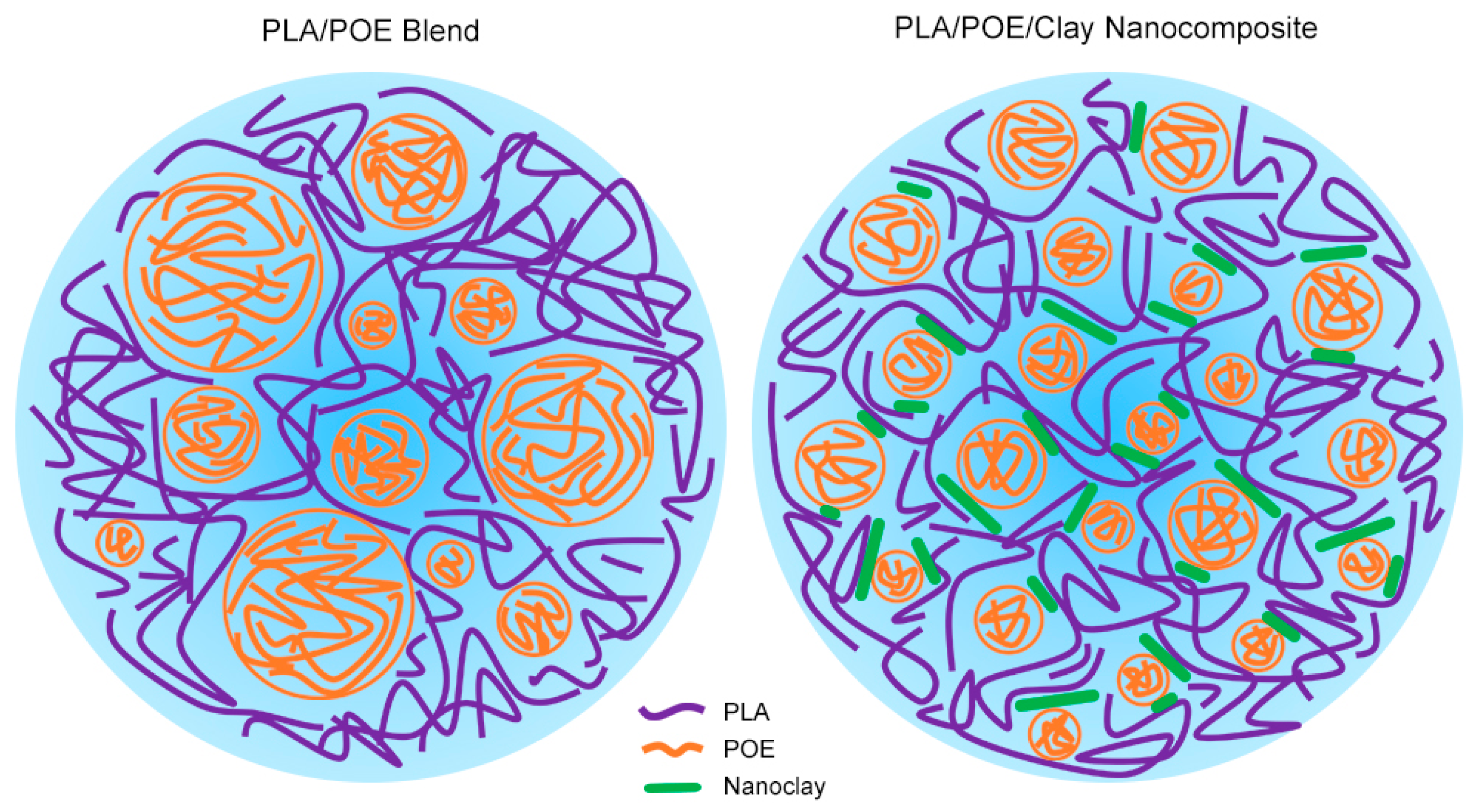
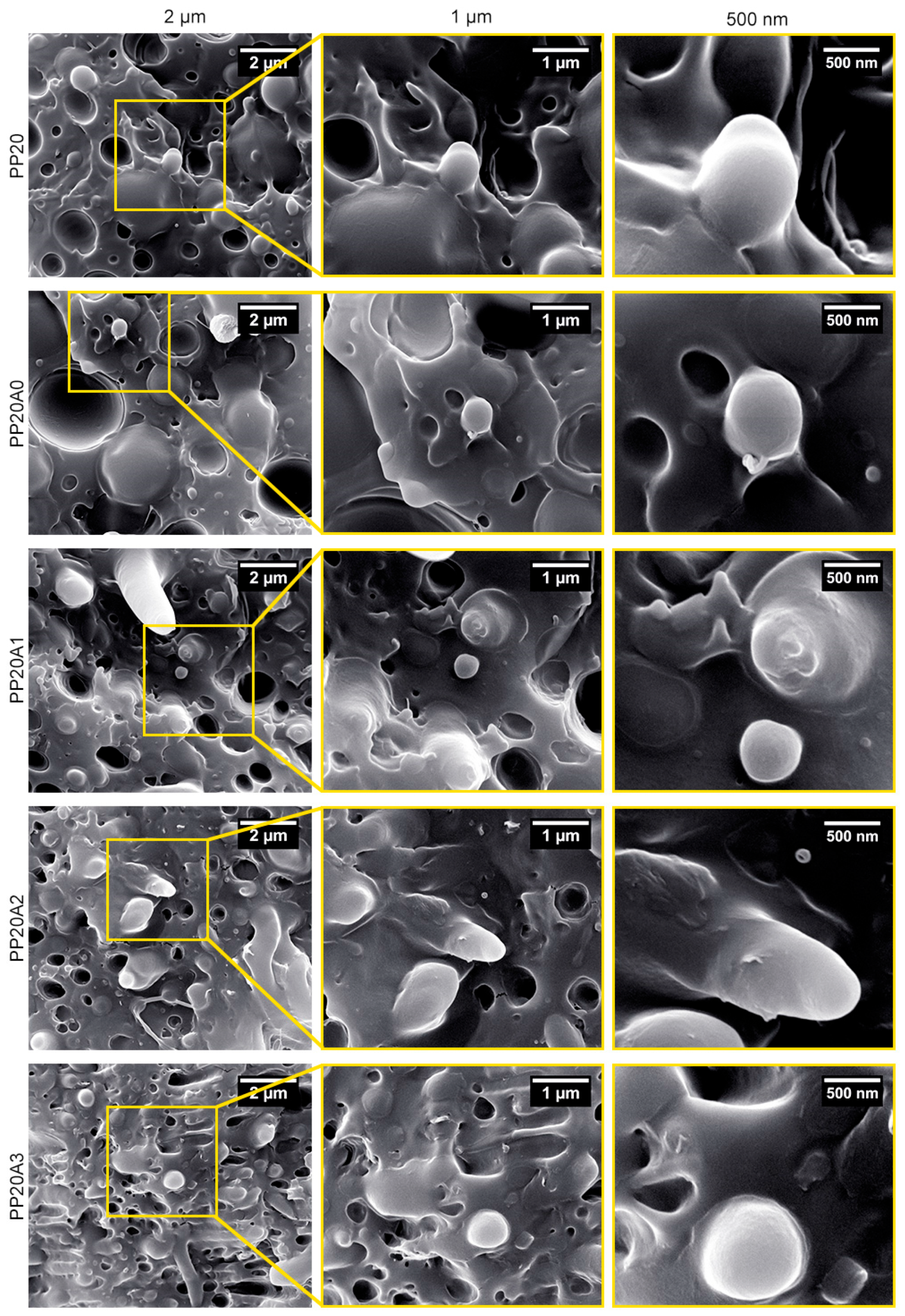
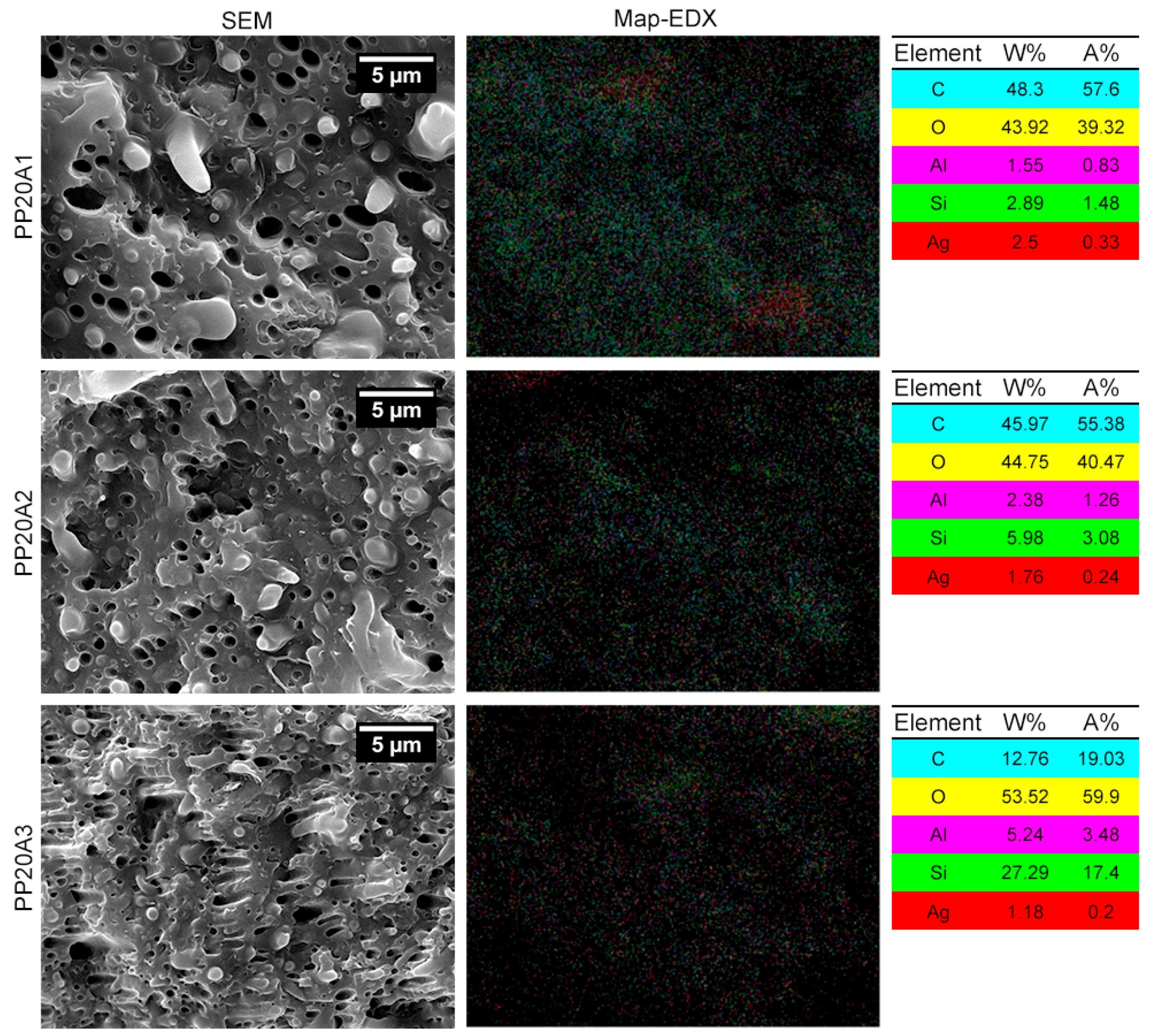
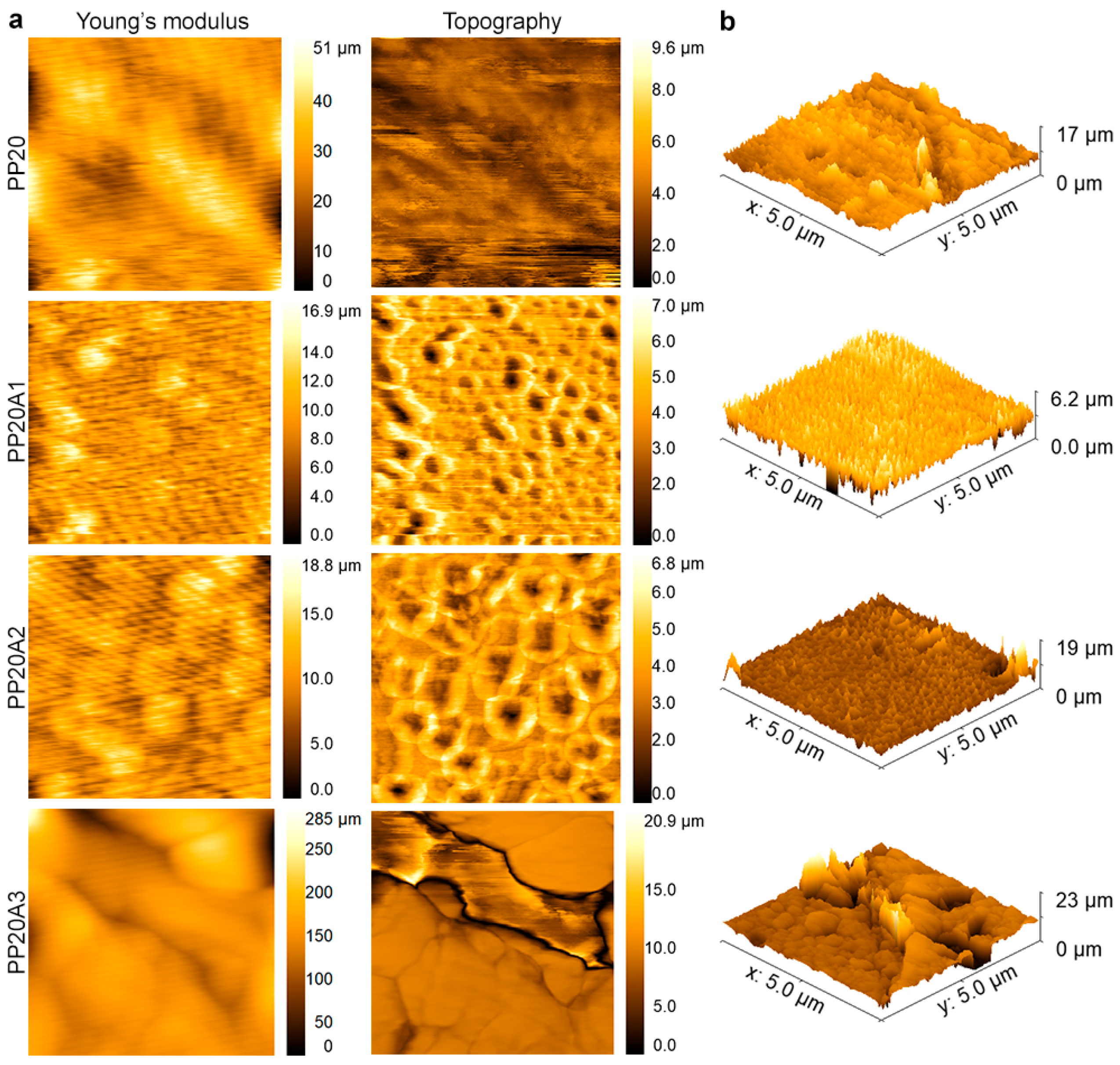

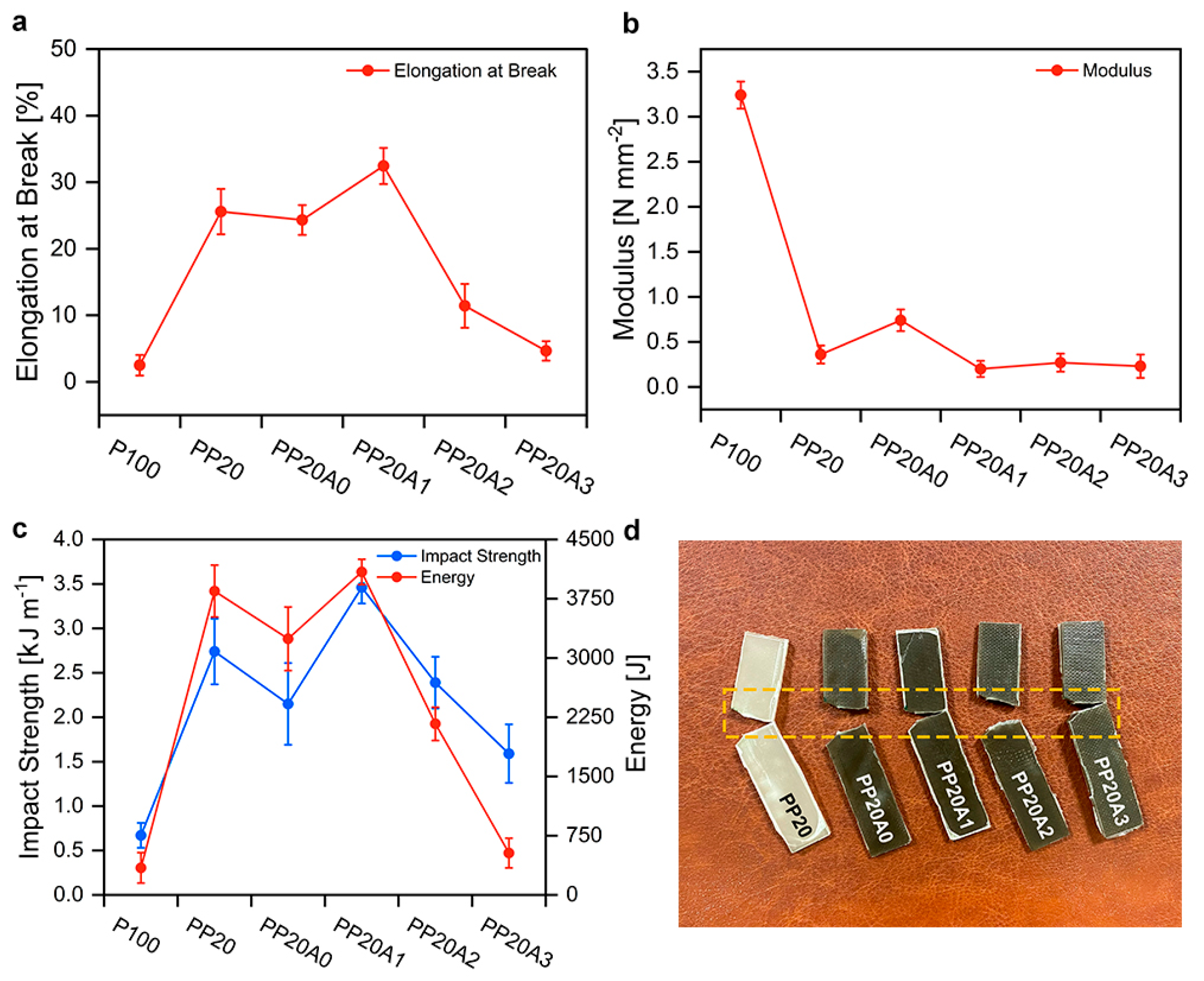
| Sample | Sample Coding | AgNPs [wt.%] | Component Composition | ||
|---|---|---|---|---|---|
| PLA | POE | Organoclay | |||
| Virgin PLA | P100 | - | 100 | - | - |
| PLA/POE | PP20 | - | 80 | 20 | - |
| PLA/POE/AgNPs | PP20A0 | 1 | 80 | 20 | 0 |
| PLA/POE/AgNPs/Organoclay | PP20A1 | 1 | 80 | 20 | 1 |
| PP20A2 | 1 | 80 | 20 | 2 | |
| PP20A3 | 1 | 80 | 20 | 3 | |
| Material | γ (mN m−1) | γp (mN m−1) | γd (mN m−1) | Reference |
|---|---|---|---|---|
| PLA | 33.9 | 3.9 | 30 | [42] |
| POE | 17.45 | 1.89 | 15.56 | [43] |
| Cloisite 30B | 35 | 12.6 | 22.4 | [44] |
| Sample Pairs | Interfacial Tension (mN m−1) | Code |
|---|---|---|
| PLA-POE | 2.71 | |
| Clay-PLA | 3.03 | |
| Clay-POE | 5.35 |
| Sample | [µm] | Height Average [µm] |
|---|---|---|
| PP20 | 23.78 ± 5.80 | 17.08 ± 3.56 |
| PP20A1 | 8.57 ± 1.39 | 6.24 ± 2.19 |
| PP20A2 | 10.41 ± 9.44 | 19.01 ± 2.38 |
| PP20A3 | 57.65 ± 18.18 | 23.04 ± 9.04 |
| Sample | Tensile Strength [N mm−2] | Modulus [N mm−2] | Elongation at Break [%] | Energy [J] | Impact Strength [kJ m−1] |
|---|---|---|---|---|---|
| P100 | 60.03 ± 15.06 | 3.24 ± 0.15 | 2.50 ± 1.55 | 343 ± 192.21 | 0.67 ± 0.14 |
| PP20 | 37.80 ± 9.51 | 0.36 ± 0.18 | 25.59 ± 3.41 | 3846.51 ± 328.65 | 2.74 ± 0.37 |
| PP20A0 | 36.06 ± 11.48 | 0.74 ± 0.12 | 24.33 ± 2.24 | 3243.86 ± 401.92 | 2.15 ± 0.46 |
| PP20A1 | 28.09 ± 3.35 | 0.20 ± 0.09 | 32.44 ± 2.71 | 4089.58 ± 159.66 | 3.46 ± 0.18 |
| PP20A2 | 33.76 ± 6.19 | 0.27 ± 0.11 | 11.43 ± 3.31 | 2166.43 ± 210.78 | 2.39 ± 0.29 |
| PP20A3 | 29.00 ± 10.03 | 0.23 ± 0.13 | 4.65 ± 1.46 | 530.49 ± 188.44 | 1.59 ± 0.33 |
Disclaimer/Publisher’s Note: The statements, opinions and data contained in all publications are solely those of the individual author(s) and contributor(s) and not of MDPI and/or the editor(s). MDPI and/or the editor(s) disclaim responsibility for any injury to people or property resulting from any ideas, methods, instructions or products referred to in the content. |
© 2023 by the authors. Licensee MDPI, Basel, Switzerland. This article is an open access article distributed under the terms and conditions of the Creative Commons Attribution (CC BY) license (https://creativecommons.org/licenses/by/4.0/).
Share and Cite
Rajabifar, N.; Rostami, A. Investigation of the Effect of Hybrid Nanofiller on the Mechanical Performance and Surface Properties of Bio-Based Polylactic Acid/Polyolefin Elastomer (PLA/POE) Blend. Polymers 2023, 15, 2708. https://doi.org/10.3390/polym15122708
Rajabifar N, Rostami A. Investigation of the Effect of Hybrid Nanofiller on the Mechanical Performance and Surface Properties of Bio-Based Polylactic Acid/Polyolefin Elastomer (PLA/POE) Blend. Polymers. 2023; 15(12):2708. https://doi.org/10.3390/polym15122708
Chicago/Turabian StyleRajabifar, Nariman, and Amir Rostami. 2023. "Investigation of the Effect of Hybrid Nanofiller on the Mechanical Performance and Surface Properties of Bio-Based Polylactic Acid/Polyolefin Elastomer (PLA/POE) Blend" Polymers 15, no. 12: 2708. https://doi.org/10.3390/polym15122708
APA StyleRajabifar, N., & Rostami, A. (2023). Investigation of the Effect of Hybrid Nanofiller on the Mechanical Performance and Surface Properties of Bio-Based Polylactic Acid/Polyolefin Elastomer (PLA/POE) Blend. Polymers, 15(12), 2708. https://doi.org/10.3390/polym15122708








